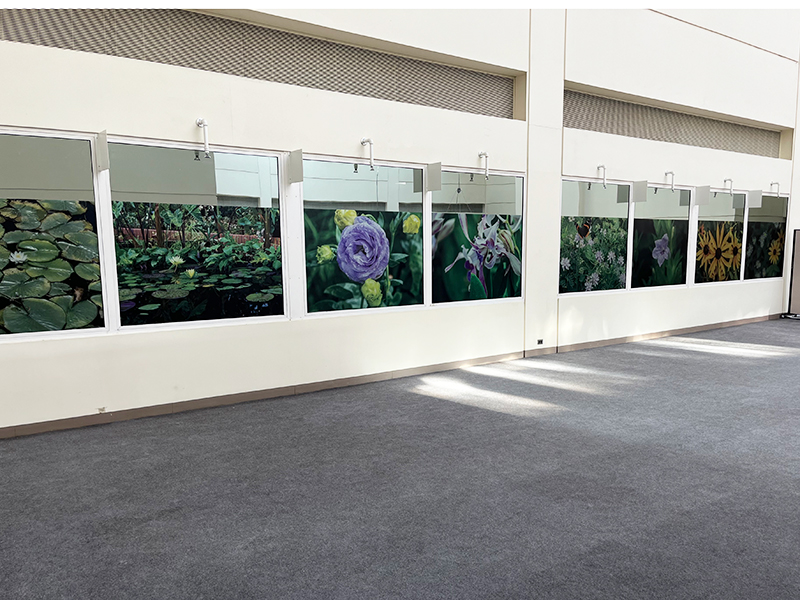A collaboration between Rush and high school students from Chicago’s West Side inspired a unique solution to a complex problem. Susan Stearn, senior construction project manager at Rush University Medical Center, needed to ensure patients’ privacy in rooms overlooking the Atrium Building. While simple solutions came to mind, such as installing basic screens, Stearn had a better idea. Why not work with local students and display their artwork in the patient rooms?
Stearn had recently learned about the Chicago Center for Arts and Technology, or CHICAT, which provides an enriching learning environment to young people and adults with access to emerging technologies, artist-led classes and vocational training — at no cost.
Stearn connected with Stuart Grais, digital arts instructor at CHICAT. Grais works with students from neighboring communities, including North Lawndale, Little Village and Pilsen. In his class, he not only teaches students how to take high-quality photos but also how to use photo editing software and, importantly, consider their audience. Through a partnership with After School Matters, CHICAT provides students in the program with a stipend.
Improving the experience of patients and staff
At the beginning of the program earlier this summer, CHICAT’s students toured the showroom of Steelcase in the Merchandise Mart. As Rush’s preferred furniture vendor and a philanthropic supporter of CHICAT, Steelcase was an ideal partner to educate the students about the impact that imagery can have on patient experience and outcomes. In particular, experts from Steelcase explained how images of nature have been shown to promote healing.
“We operate as though we’re a design firm and work together as a team,” Grais explained. “With Rush as our ‘client,’ we think about how the photos we take can improve the patient experience. I encourage the students to look for colors and visuals that are calming. The students are incredibly talented, wonderful young people and jumped at the opportunity.”
Over the course of the eight-week program, the students took hundreds of photos at locations across the city, including Garfield Park Conservatory, Lincoln Park Zoo and the Art Institute of Chicago. They captured calming images of nature — from flowers to lily pads to animals.
“I loved taking photos at the Garfield Park Conservatory,” said London Turner, a student in the CHICAT program who will be a sophomore at UIC College Prep in the fall. “Someday, I’d like to buy my own camera and take photos of my family.”

Making an impact
With philanthropic support from Steelcase, Stearn was able to print and install the students’ photos on nontoxic film on the seventh and eighth floors of the Atrium at Rush University Medical Center, including the mother-baby unit. Now, she’s looking to install more photos on the ninth floor, as well as other locations in the hospital, including near elevators and along “Main Street” on the fourth floor.
The students’ photos not only enhance the patient experience but also that of staff, including nurses, environmental services team members and others who are in and out of patient rooms throughout the day.
Stearn’s efforts exemplify Rush’s I CARE values — innovation, collaboration, accountability, respect and excellence. Innovation especially stands out, as this project represents an elegant solution to a complex problem.
But Stearn is more interested in the impact the project has on others.
“It’s been especially exciting to see the potential of the students,” Stearn said. “Many of them go from never having used a camera before, other than the one on their phones, to taking professional-quality photos that can be displayed across the hospital.”
Second-year program participant Joshua Dorden noted that what he’s learned through the CHICAT program and the partnership with Rush extends beyond using a camera.
“The program gave me firsthand experience to understand how lighting impacts color, how to set a scene and how to use a studio,” said Dorden, who will be a junior at De La Salle Institute in the fall. “I want to go to college to continue to develop my skills and grow my love for photography.”
Students who participated in last summer’s program had the opportunity to see their photography on display at Rush.
“Seeing our work really showed we’re making an impact — we’re really helping people,” Dorden said.
“It was incredible to see the look on the students’ faces when they saw their work on display for the first time,” Grais added. “They were beaming.”




